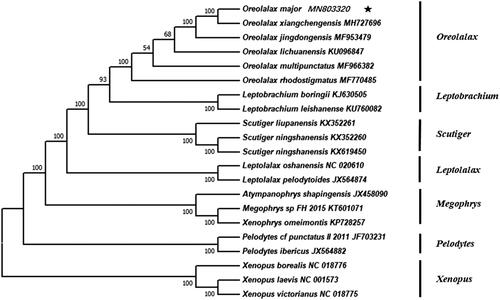Abstract
The complete mitochondrial genome of the Oreolalax major (17,786 bp long) was obtained in this study. It includes 13 protein-coding genes (PCG), two ribosomal RNA (rRNA) genes, and 23 transfer RNA (tRNA) genes (GenBank accession number MN803320). The phylogenetic tree indicates that the O. major is closely related to the O. xiangchengensis.
The large toothed toad (Oreolalax major), belonging to the family Megophryidae, ranges in montane regions of southern Gansu (Wenxian County) and central Sichuan (Beichuan, Baoxing, Emei, Dujiangyan, Hongya, Luding, Pingshan and Wenchuan counties), China (Fei et al. Citation2012; Frost Citation2020). The near complete mitogenome of O. major has been reported by (Liu et al. Citation2017). Here, we further provide a complete mitogenome of O. major, which helps to further understand the information of O. major and explore the phylogenetic relationship among the genera of Megophryidae.
The sample of O. major was obtained from Wawushan Nature Reserve (29°34′26.72″N, 102°56′35.73″E., elev. 1394 m), Sichuan Province, China, and the specimen was deposited in the Museum of Sichuan Agricultural University (Specimen voucher: 20120256). We extracted the total DNA from ethanol-preserved muscle tissue using the Ezup pillar genomic DNA extraction kit (Sangon Biotech, Shanghai, China). DNA sample was sent to Personal Biotechnology (Shanghai, China) for library construction and sequencing on an Illumina MiSeq platform (PE400).
The new O. major mitogenome (MN803320) sequence is 17,786 bp long and contains 13 protein coding genes (PCGs), two ribosomal RNA (rRNA) genes, 23 tRNA genes (including an extra trnM gene) and a control region (D-loop). The base composition of the mitogenome is 28.75% A, 14.31% G, 24.31% C, 32.63% T. The mitogenome structure of O. major is similar to that of other Megophryidae (Xiang Citation2013; Liang Citation2016; Liang et al. Citation2016). Eight tRNA (tRNA-Gln, Ala, Asn, Cys, Tyr, Ser, Glu, and Pro) and the nad6 genes are encoded on the L-strand, and the rest of genes are encoded on the H-strand. Among the 13 PCGs, the start codon of the nad3 is ATA, three PCGS (cox1, cox2, and nad6) initiate with GTG, and the rest nine PGCs use ATG. For the terminal codon, three PCGs (cox1, nad5 and nad6) use AGG as stop codon, and three (nad2, atp8 and nad4l) ended with TAA. Two PCGs (nad1 and atp6) ended with TA, whereas four (cox2, cox3, nad4 and cytb) ended with incomplete stop codon (T-). The two rRNA genes (12S and 16S) are 937 and 1,579 bp in length, respectively. Within the genus of Oreolalax, the O. rhodostigmatus mitogenome was the largest, at 18,676 bp, followed by O. jingdongensis (17,864 bp), O. major (17,786 bp), O. lichuanensis (17,702), O. multipunctatus (17,358 bp), and O. xiangchengensis (17,110 bp). Comparing the intraspecific mitogenome size variation in this toad, the mitogenome of O. major (17,786 bp) from Wawushan in this study is larger than that (17,431 bp) from Luding reported by Liang et al. (Citation2016). The differences in mitogenome size was due to the size variation in control region.
We used MEGA7.0 (Kumar et al. Citation2016) to reconstruct the phylogenetic tree of the family Megophryidae. The final alignment consisted of 21 species from seven genera (Oreolalax, Leptobrachium, Scutiger, Leptolalax, Megophrys, Pelodytes, and Xenopus). Phylogenetic trees based on these mitochondrial genomes show that O. major was the sister taxon to O. xiangchengensis (). This complete mitogenome would contribute to further investigations of molecular evolution and conservation of genus Oreolalax.
Acknowledgments
Thanks to Hongdi Luo in our lab for his help in data analysis.
Disclosure statement
No potential conflict of interest was reported by the author(s).
Additional information
Funding
References
- Fei L, Ye C, Jiang J. 2012. Colored Atlas of Chinese amphibians and their distributions. Chengdu: Sichuan Publishing House of Science and Technology.
- Frost D. 2020. Amphibian species of the world: an online reference. Version 6.0. New York, NY: American Museum of Natural History. http://research.amnh.org/herpetology/amphibia/index.html.
- Kumar S, Stecher G, Tamura K. 2016. MEGA7: molecular evolutionary genetics analysis version 7.0 for bigger datasets. Mol Biol Evol. 33(7):1870–1874.
- Liang X, Wang B, Li C, Xiang T, Jiang J, Xie F. 2016. The complete mitochondrial genome of Oreolalax major (Anura: Megophryidae). Mitochondr DNA Part B. 1(1):118–119.
- Liang X. 2016. Structure and evolution of mitochondrial genomes of megophryidae [PhD Dissertation]. Beijing: University of Chinese Academy of Sciences.
- Liu F, Liu Y, Li Y, Ni Q, Yao Y, Xu H, Yang M, Wang T, Wang J, Rao D, et al. 2017. First near complete mitochondrial genome of large toothed toad, Oreolalax major (Anura: Megophryidae) from southwest China. Mitochondr DNA Part B. 2(1):37–38.
- Xiang T. 2013. Analysis of complete mitochondrial genomes in representative species of three subfamilies of Megophryidae (Amphibia, Anura) [MsD Dissertation]. Beijing: University of Chinese Academy of Sciences.

